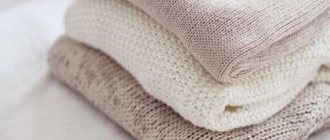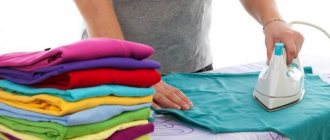A convenient and comfortable wool sweater is definitely in every person’s wardrobe. Warm wool is the best protection against the cold, but improper washing can bring an unpleasant surprise. Having taken the item out of the machine, you may be surprised to notice that now this item of clothing will only fit on a cat, and that is not a fact, or, on the contrary, it is becoming too big. To avoid finding yourself in this situation, you need to know in advance what the rules are for washing and drying a sweater.
Wool clothing requires more attention than synthetic clothing. Clothing labels include tips for washing, ironing and drying.
General rules for washing woolen clothes
To prevent your favorite item from increasing in size or shrinking, you should follow simple rules for washing clothes:
Wool is washed as rarely as possible. These things are not fans of water, so avoid it if possible. If the sweater has absorbed an unpleasant odor, refresh it by hanging it in the air; Do not leave wool in water for a long time before washing. If you do not want to deform or reduce the size of the item, then do not keep it in water for a long time; Maintain temperature stability. If woolen clothes are washed in water at one temperature, and then rinsed in too hot or cold water, then after that they will certainly change size.
Follow the basic washing rules, then your favorite sweater will delight you for a long time.
To prevent the sweater from shrinking and stretching, you should not use extreme water temperatures. The best option would be 30 degrees.
Important Features
To make your work easier, you need to take into account the characteristics of the material:
- Cotton fabric must be ironed on both sides, otherwise it will still look untidy.
- It is advisable not to leave silk bedding until completely dry, but to begin ironing it while still damp. Iron only on the reverse side, do not splash water on it.
- It is harmful to use additional moisture when processing satin linen. It must be laid out on the ironing board with the wrong side up and the “dry” method used to avoid water stains.
- It is better to go over the chintz with an iron from the front side, not forgetting to wet the surface with a spray bottle.
- To quickly iron synthetic fabric, use gauze or a thin, clean cloth. The main product must first be completely dried.
- Dark colored material must be ironed correctly from the wrong side, otherwise there is a high risk of shiny marks appearing on the fabric.
- If there are decorative elements on the linen in the form of applique or embroidery, you can treat them with a steamer. Iron only from the inside out, placing the decor on a soft terry towel.
Hand washing a wool sweater
It is better to wash a wool sweater by hand. This way you definitely won't harm him. Start by turning the garment over to the wrong side. Take a container and fill it with water no more than 35 degrees. If the item is made of delicate wool, then it is more advisable to use liquid wool powder. But if this is not the case, then use simple shampoo.
Do not place the item in clean water. To begin, pour the product or pour the powder and dissolve thoroughly, whipping into foam. Only then place clothes in the container.
You cannot wash or rub such things too much, otherwise the wool will mat and lose its beauty. It is enough to wrinkle the sweater a little in the foam. Then rinse it in water with a suitable wool product added. Remember that you cannot use too cold water for rinsing; use the same temperature as for washing.
Cotton care
Cotton products are very durable, withstand high temperatures well, and are a very dense fabric. A special feature of cotton fabric is its excellent ability to absorb moisture. The disadvantages of cotton are its high wrinkleability and strong shrinkage when washed. Cotton takes a very long time to dry after washing. Cotton fabric can be washed in a washing machine at a temperature of 30 - 40 degrees. For washing white laundry, use universal detergents; for colored laundry, use mild detergents and products without bleach. A heavily shedding item should be washed only in cold water and dried in a well-stretched form immediately after rinsing. Add salt to the rinse water (1 tablespoon per 10 liters).
To determine whether a colored item is fading, wet the tip and wring it out in a white cloth. If there is a colored stain left on the cloth, wash the colored item separately from the others.
Cotton items can also be machine dried, but remember that this can cause them to shrink a lot. It is recommended to hang items with an enriched finish wet to dry. Iron cotton fabrics using an iron with a humidifier.
Washing a wool sweater in a machine
If you are unable to clean a wool sweater with your hands, you can use an automatic washing machine. In addition to the powder, it is important to add rinse aid. Remember that you should not put other things in the drum, and it is also important to choose the right mode:
washing such items in a machine is risky, since you may end up with a very shrunken item of clothing; be sure to purchase a suitable powder and rinse for wool; place the sweater in the laundry bag; pour detergents into the compartments and add conditioner; set the appropriate mode. Machines often have a special function for woolen clothes. If this is not the case, then choose hand wash or delicate wash. This is the only way to ensure the safety of the product;
For wool clothing, hand washing is preferable. Machine assistance is rarely used and only when absolutely necessary.
To avoid damage, it is important to carefully select the water temperature. Too hot causes shrinkage, so check the temperature when setting the mode. Suitable 30 degrees; sometimes the mode setting has to be done manually; turn off spin. Even if you use a gentle setting, the item is damaged, since the drum speed reaches at least 500 revolutions. And you shouldn’t wring out a wool item even when washing it by hand. Wait a little after the end of the program until the water drains on its own.
In order not to increase the size of the sweater, it is also important to set a regime that is not too long - no more than 40 minutes. Remember that frequent use of machine washing degrades the quality of wool sweaters.
Important nuances
If you like your sweater and don’t want it to soon become unwearable, then be sure to remember the important nuances of caring for wool products:
If stains form on woolen clothes, do not rush to wash them. Dry the area with the stain, and then remove it with a brush; other types of stains are removed by using a solution of ammonia and vinegar, salt and water. Mix these components in equal parts and soak natural fabric in the solution. Then tap it on the dirt. Now you can’t stain, it will stretch the tissue and small pellets will appear;
It is better to clean an Angora wool sweater using shampoo. This will keep the fur fluffy longer; You can get rid of yellowness by using water and lemon juice; You can wash woolen clothes like this: pour a handful of mustard powder into 3 liters of boiling water and cool to 30 degrees. The solution is foamed. This will help you wash your sweater easily; To prevent the button loops from stretching, they need to be basted a little before washing.
Flax care
Linen fabric has a smooth surface and matte shine. Products made from linen get dirty a little, do not lint, absorb moisture well and dry quickly. Linen fabric is particularly durable. The noble properties of flax include its great creasing properties. Linen fabrics can be boiled. The washing temperature is selected depending on the finish of the fabric. Linen products can be washed in a washing machine at a temperature of 30 - 40 degrees. Colored fabric is washed at 60 degrees. Linen items may shrink after washing. Iron them with a well-heated iron with a humidifier.
How to dry a wool sweater
Even if there is no surprise after washing, the item is easily damaged if it is not dried properly. To prevent this from affecting you, you should not twist the sweater after washing, just wrinkle it a little. This is done carefully, without effort. It is enough to leave the sweater on a stand or in a basin to allow the water to drain.
After a couple of hours, the sweater begins to dry. For this purpose, carefully spread it on a towel, trying not to stretch it, and then roll it into a sausage. Give the fabric time to absorb the water from the item. Then unwind the “sausage” and repeat the manipulations again, but with a dry towel.
Next step: lay out the sweater on a flat surface, first laying down a sheet. Dry your clothes in this position for several hours. Remember, to prevent the sweater from shrinking in size, do not leave it in the sun or on a heater.
Drying and ironing are no less important nuances. There are also certain rules for wool sweaters.
There is a certain trick: if you pull a wet sweater to the sides when drying, you can stretch it a little if it has shrunk a little. Along with this, the product is reduced by folding and then laid out near a heat source.
Basic ironing modes
Even novice housewives know that the iron can be used in several modes. But not everyone understands the intricacies of the differences between different ironing methods. But the result largely depends on the right choice!
There are three main modes of using the iron:
- The dry regime is the most ancient. It was used in the very first irons, in which heating was carried out by the heat of coals embedded in the body. The smoothing effect in this mode is provided by the weight of the iron, the sliding of its sole and the surface temperature. The main disadvantage of the regime is the high risk of damage to things. If you hold the iron in one place, a charred spot will appear.
- Ironing dampened fabric. In this case, the product to be smoothed is wetted using a spray bottle or wet gauze. Moisture makes fabric fibers softer, reduces friction and makes ironing easier. The disadvantage of this method is the need to manipulate additional devices. It takes experience to learn how to properly moisturize your clothes.
- Steaming mode. In it, the iron creates a stream of steam, which is directed through special holes on the sole onto the item. Steam allows you to effectively and quickly deal with wrinkles on fabric. However, the built-in steamer complicated the design of the iron, which means it increased the price of the device and made it more difficult to operate and care for.
The preference for one mode or another should not negatively affect the service life of the iron
But it is important to understand in what cases each ironing method is used, otherwise more labor will be required. The risk of clothing damage if ironing is done incorrectly also increases.
How to iron a wool sweater
After drying, ironing is often not necessary. But if the folds remain, you can iron the sweater. All products have a label indicating care instructions. If it is missing or worn out, then follow the general rules for ironing wool products:
iron the wool only after it is completely dry; before manipulation, turn it inside out; to avoid the appearance of shiny stripes, pass the iron through gauze or cotton fabric; The iron cannot be “pulled” over the sweater; it must be “lowered” onto it. This will preserve the shape of the product; The appropriate temperature for wool is often written on the iron. Usually this is the 2nd division.
We hope that such information will help you in caring for your favorite sweaters, which will delight the eye with pleasant cleanliness and impeccable quality. But it’s also worth considering the nuances of correcting errors if they have already happened.
Ironing
Ironing is one of the most important and necessary steps in caring for fabric and products. With proper ironing or steaming, you can delay the next cleaning. For example, this applies to products made from suit wool and coats. Steaming in this case raises the pile (or micropile) and partially removes contaminants from the fabric structure, and cleaning occurs. If the fabric has a voluminous texture or volume (for example, knitted jersey), you need to iron it without pressure or even at a distance of 2-3 centimeters from the surface. This applies to any type of fabric. Always iron fabrics in one layer. A great way is to use a vertical steamer. Hang the product/fabric on a mannequin or hanger and use a steamer. If you steam a product at home, without special tailoring equipment (pads), and you need to steam hard-to-reach places (for example, the side under a sleeve, etc.) and small parts (for example, pocket flaps, places of relief darts, etc.), use a special heat-resistant glove. They are sold in hardware and sewing stores and are very convenient to use. If the fabric is embroidered with beads, sequins, beads, etc. - use a steamer. Use steam at a distance of several centimeters so that the folds on the base are straightened out, but the beads and sequins, especially plastic ones, do not melt. Yes, this can really happen) Another important note regarding embroidered fabrics - glass beads and seed beads can scratch the surface of the iron.
Life hack
How to iron so that no stripes remain? There are two ways, and here you can choose the one that is more convenient for you. The first is to use a Teflon attachment on the sole of the iron, the second is to use an iron - a piece of fabric, usually clean white calico or gauze, through which you will iron. When you use a vertical steamer, the appearance of lass is eliminated. When ironing synthetic knitted fabrics, use a special ironing mesh to avoid any laces remaining. It is sold in hardware and sewing stores.
Restoring a sweater after deformation
What to do if an unpleasant situation has already occurred after washing a sweater? How is a sweater restored when it shrinks or stretches?
In order to increase the size of shrunken clothes, you need to wet them again, in addition to the neck and shoulders. Do not twist it, but wrap it in a towel. When the excess liquid is absorbed, stretch the sweater in different directions and hang it on a trempel, wrapping it with fabric. Another option for increasing the size: wet the item and lay it out to dry. From time to time you need to stretch it with your hands, remembering the sleeves. After almost complete drying, the sweater is hung on the trempel.
If trouble has already happened, then you can try to fix it. But all methods help only with minor changes.
Treat the item with a vinegar solution for steaming. Pour more vinegar into the water into the container and, without touching the product with the iron, steam it. While the wool is heated, stretch it with your hands, not letting go until it cools. You can also steam a piece of clothing through gauze. But they do this at low temperatures so as not to experience large shrinkage in size. There is another, unpleasant, but effective method - put the wet thing on yourself and wait for it to dry.
It happens that the sweater increases in size, then you need to tighten it. Soak the item for 15 minutes in hot water and wash by hand. But remember that trying to shrink a sweater by using a machine wash will result in complete destruction of the garment, because it will not be possible to achieve an even reduction.
How to iron a sheepskin coat safely - learning ways
There are many ways to iron a sheepskin coat without resorting to the services of professionals.
- Method one: let the product hang on hangers for one to two weeks. Yes, it takes a long time, but it is completely safe.
- Method two: steam the sheepskin coat over a bath of hot water. The bathroom should be tightly closed to keep the hot steam as long as possible. The “bath” time is about half an hour.
- Method three: treat the jammed areas with a steamer on an iron or a special steam generator. Processing each fold should last approximately twenty minutes. The permissible distance to the surface of the product is ten centimeters.
- Method four: ironing. You can iron the folds on a sheepskin coat with a regular iron. The temperature should be minimal, without steaming. Ironing must be done through thin wrapping paper.
Important! When steaming a sheepskin coat, you need to ensure that moisture does not get (or form) on the surface. This can ruin your skin.
Conclusion
We hope our article will help you quickly put in order such outerwear as a raincoat, sheepskin coat, or faux fur coat. We will be glad to see your comments on the article!
How to return a sweater to white
It happens that over time, things made of wool lose their whiteness and a yellow tint appears. How to return the white color to a product? Is there a way to get rid of yellowness?
Due to exposure to the sun and hard water, a white sweater can easily change color to yellowish. The situation can be corrected without dry cleaning. For this, there are special stain removers that are designed for natural materials, including wool.
But before using them, use gentle methods. As an example, soaking in powder with bleach. In this situation, the sweater should be allowed to rest in the middle of the process. And after a couple of washes it will almost restore the color.
If whitening powder does not help, then use peroxide. It should be added to the water during the washing process, in the amount of 3 spoons per 1 liter of water. In such a situation, the item should be left in water overnight. Often, only 2-3 similar manipulations are needed to refresh the color.
Bleaching often fails due to contamination not of the threads, but of the spools. In such a situation, use emollients with bleach. They will help untangle threads and remove dirt.
If all efforts do not produce results, then you should turn to professionals for help, that is, dry cleaning. If nothing helps here, then it’s time to say goodbye to the thing and look for a replacement.
Without steamer
If you don’t have a steamer or iron at home, or, for example, there’s a power outage, you can straighten the curtains using steam. You need to get steam by simply boiling water. For this method you will need a kettle (gas or electric) or a small saucepan filled with water. Bring the water to a boil and continue boiling for another 5 minutes. Then take a container of boiling water and bring it to the hanging curtain. Direct the steam so that it hits the fabric. Use your hands to straighten the fabric and remove creases. The material smooths out before our eyes and has a neat appearance. For better results, you can slightly wet the curtains with a clean damp cloth; they will smooth out much better and faster.











